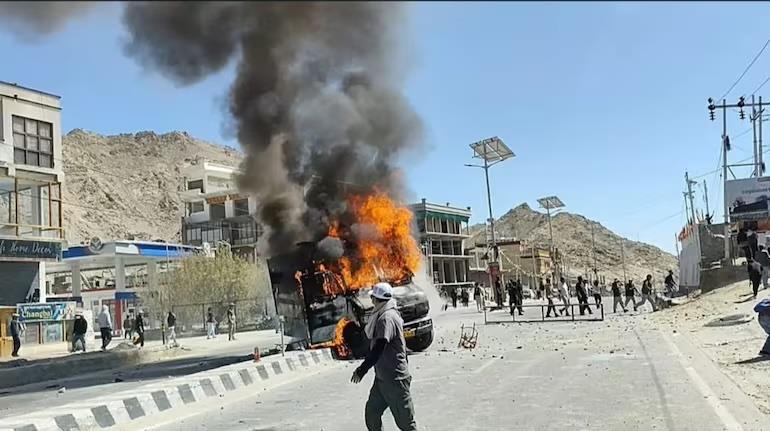Ladakh On The Boil: Between Promises, Protests, And Peace
Ladakh on the Boil
Leh, Ladakh – The windswept plateau of Ladakh, often romanticised as the“roof of the world,” turned into a theatre of violence on Wednesday as clashes between protesters and security forces left four dead and at least 70 injured. The unrest marked one of the most serious flare-ups since Ladakh was carved out as a separate Union Territory (UT) in August 2019 following the abrogation of Article 370.
The Ministry of Home Affairs (MHA) squarely blamed the crisis on Sonam Wangchuk – the celebrated Ladakhi engineer, education reformist, environmental innovator, and Ramon Magsaysay Award recipient.“In spite of many leaders urging to call off the hunger strike, he continued with it and misled the people through provocative mentions of Arab Spring-style protest and references to Gen Z protests in Nepal,” the MHA said in a strongly worded statement. According to the government, mobs“guided” by Wangchuk's speeches stormed the BJP headquarters, torched the Leh Hill Council Assembly hall, and attempted to burn down a CRPF vehicle with personnel inside.
The Activist's Defence
Wangchuk, however, rejected the government's accusations, calling the unrest an“organic outburst” of frustration among Ladakh's young population.“This is the saddest day for Ladakh and for myself personally... The path we treaded for the last five years was peaceful,” he said in an emotional appeal, announcing the premature end of his hunger strike.
He accused the BJP of reneging on promises made in 2020 – particularly statehood and constitutional safeguards – while youth in the region grapple with joblessness and fears of cultural erosion.“We will keep our agitation non-violent... but when the message of peace is ignored, such a situation arises,” he added, urging both restraint among youth and dialogue from the government.
The Roots of the Crisis
At the heart of the turmoil lies Ladakh's demand for inclusion under the Constitution's Sixth Schedule – a framework that grants tribal-majority regions in the northeast special powers for self-governance through autonomous councils.
The Leh Apex Body (LAB) and the Kargil Democratic Alliance (KDA) – representing Buddhist-majority Leh and Muslim-majority Kargil respectively – have been spearheading the agitation jointly since 2020. Their unity is rare in Ladakh's fractious politics, but both sides share fears that without constitutional protections, outsiders will dominate land, jobs, and resources, marginalising Ladakhis.
For four years, Ladakh has witnessed hunger strikes, marches, and shutdowns. Tuesday night's call to shutter Leh town signalled rising tensions that exploded into Wednesday's deadly violence.
Promises and U-Turns
When Ladakh was separated from Jammu and Kashmir and made a UT without a legislature, the Centre promised safeguards. However, four years on, no constitutional mechanism has been put in place. In fact, the Centre's interlocutors reportedly stalled talks with LAB and KDA earlier this year, citing lack of consensus.
“The people of Ladakh welcomed the UT status in 2019 with hope. But now there is only disillusionment,” says political analyst Stanzin Dorje.“The lack of elected representation, shrinking job avenues, and unaddressed environmental concerns have created a pressure cooker situation.”
The Man at the Centre

Legal Disclaimer:
MENAFN provides the
information “as is” without warranty of any kind. We do not accept
any responsibility or liability for the accuracy, content, images,
videos, licenses, completeness, legality, or reliability of the information
contained in this article. If you have any complaints or copyright
issues related to this article, kindly contact the provider above.
Most popular stories
Market Research

- Cartesian Launches First Outsourced Middle-Back-Office Offering For Digital Asset Funds
- R0AR Launches Buyback Vault: Bringing 1R0R To R0AR Chain Unlocks New Incentives
- FBS Analysis Shows Ethereum Positioning As Wall Street's Base Layer
- Bydfi Joins Korea Blockchain Week 2025 (KBW2025): Deepening Web3 Engagement
- Ethereum Based Meme Coin Pepeto Presale Past $6.6 Million As Exchange Demo Launches
- Moonbirds And Azuki IP Coming To Verse8 As AI-Native Game Platform Integrates With Story






















Comments
No comment